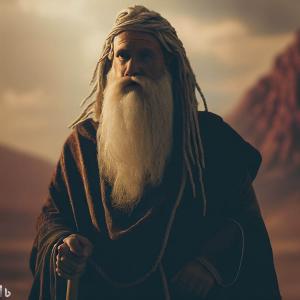
Today we take a break from The Women In The Bible Series to learn about the historicity of Moses from our guest blogger Joseph Parks.
Ancient Egypt and the Bible
Article 4 – The Historicity of Moses
Joseph DeWayne Parks RN, BSN
August 3, 2023
The Evidence for Moses
“From Moses to Moses, there was none like Moses” This saying, which can be found on the tombstone of the medieval Jewish philosopher and rabbi Moses Maimonides, states that although there have been many great leaders of the Jewish community – and that many of them shared the name Moses – it is the original Moses who was the greatest figure of Jewish history. Like Joseph in the previous article, we also don’t have any direct archaeological or Egyptian records that identify the Hebrew liberator and lawgiver Moses (מֹשֶׁה) as a real historical figure. However, many of the events that occur with the Torah do suggest that there had to be a leader of the Hebrews who united them under one God and delivered them from Egypt into Canaan. There is also a scant amount of literary and indirect archaeological evidence that suggests a Moses-like figure did exist.
Dating Of Moses’ Life
The first issue that comes with confirming or denying the historicity of Moses is the issue of when he lived. The lifetime of Moses is codependent on the period of the Exodus, but no one truly knows when the Exodus occurred, or if it even happened. However, there is one artifact that we can use to give us a rough estimate of when Moses lived and when the Exodus occurred.
The artifact in question is the Merneptah Stela – a granite stela that was discovered by Flinders Petrie (June 3, 1853 – July 28, 1942) in 1896, measures almost 7 1/2 ft. high and 3 1/4 ft. wide and came from the funeral chapel of Pharaoh Merneptah (1224-1214 B.C.) in the Valley of the Kings (Tomb KV8) at Luxor, Egypt. The stela was originally inscribed by Pharaoh Amenhotep III (1391-1353 B.C.) but was recycled by Pharaoh Merneptah to celebrate his militaristic victory over Libya and various peoples in Syria-Palestine in 1208 B.C. The stela now rests in the Egyptian Museum in Cairo.
The Merneptah Stela
The Merneptah Stela contains the only known reference to Israel in ancient Egypt. “Israel” is referred to in the hieroglyphs as a “people” rather than a “nation” based on the determinative hieroglyphs used at the end of the name. This would indicate that the Israelites were living as a tribal confederation at this time as depicted in the Book of Joshua and the Book of Judges. If the events of the Book of Exodus are historically accurate, that means that the Exodus had to have occurred before 1208 B.C. per the Merneptah Stela.
Therefore, Moses also had to live before 1208 B.C. But can we be more specific on when Moses lived? Well, based on two theories on dating the Exodus that are the most popular amongst modern biblical scholars and archaeologists, Moses could have lived either during the 15th century B.C. or the 13th century B.C. For those who accept the 15th century B.C. dating theory, the Exodus would have occurred in ca. 1446 B.C. and during the reign of Pharaoh Amenhotep II (r. ca. 1450-1412 B.C.). For those who accept the 13th century B.C. dating theory, the Exodus would have occurred in ca. 1230 B.C. and during the reign of Pharaoh Ramesses II (1279-1213 B.C.).
Moses an Egyptian Name?
Now that we have come up with a rough estimate of when Moses may have lived, do we have evidence that the Torah’s depiction of Egypt is accurate? Let’s start with the name of Moses and many other names that appear within the Book of Exodus. Biblical scholars have made an interesting discovery. They noticed that most of the names of Israelites that come from the Tribe of Levi are of Egyptian origin – the most important being the name Moses itself!
While the original Hebrew version of Moses’ name “Moshe” roughly means “to draw up” and is a reference to the pharaoh’s daughter saving Moses when he was an infant at the Nile River, the name Moses sounds very similar to the Egyptian word “Msy”, which means “born of” and is used commonly in Egyptian names that incorporate the name of Egyptian deities such as Ramesses (born of Ra) and Thutmose (born of Thoth).
Egyptian Name Debated By Rabbis
The fact that Moses’ name is likely Egyptian of origin has been noted in the writings of the 1st century A.D. Jewish philosopher Philo of Alexandria and the 1st century A.D. Jewish historian Josephus. However, many rabbis like Rabii Issac ben Asher ha-Levi of the 11th century A.D. and Rabbi Hezekiah be Manoah of the 13th century A.D. have tried their best to deny an Egyptian influence over Moses’ identity. They argued that the Egyptian princess who saved Moses must have known Hebrew to give him his name.
However, the fact that Moses’ name is of Egyptian origin makes it more likely that he was a real person who lived in Egypt since it is reasonable to understand that the Israelites may have adopted elements of Egyptian culture during the 450 years of enslavement there. Other Levite names that are of Egyptian origin include Aaron (which might have come from Aaru – the ancient Egyptian equivalent of Heaven – or another ancient Egyptian name that roughly means “warrior lion”), Miriam (which might come from the Egyptian word for “beloved”), Hur (which is the original Egyptian pronunciation of the name of the sky god Horus), Pashur (which means “son of Horus”), Phineas (which means something along the lines of “dark-skinned one”, “bronze-skinned one”, or “Nubian”), and Hophni (which means “tadpole”).
Authentic Egyptian Names As Evidence
Just like in the story of Joseph, the story of Moses also includes authentic Egyptian places and even ancient Egyptian words that were adopted into the Hebrew text. According to the Book of Exodus, the Hebrew slaves are forced by the Egyptians to construct – not the Pyramids at Giza as depicted in Hollywood films – but the cities of Pithom and Ramses.
These cities do exist in the archaeological record and the second city is better known as Pi-Ramesses. Pithom comes from the Egyptian name “pr-jtm”, which means “the house of Atum” and called that due to being the home of a temple dedicated to the Atum – the Egyptian god associated with creation by the priests at Heliopolis and the god of the Sun at dusk. P-Ramesses comes from the Egyptian name “pr-r’-ms-sw”, which means “the house of Ramesses” and was called that due to being the capital city of Egyptian during the reign of Pharaoh Ramesses II.
Egyptian Culture In Exodus
Other authentic Egyptian place names that appear in the Book of Exodus is the Hebrew name for the Nile River “yeor”, which came from the Egyptian name for the Nile River “iteru” and many of the places that Moses and the Israelites establish camp while marching to the Sea of Reeds such as Succoth, Migdol, and Baal-zephon.
Elements of Egyptian culture also decorate the text with unique details that indicate the author(s) of the Book of Exodus had to have been in Egypt to understand them. These elements of Egyptian culture include the use of Semitic slaves for constructing city buildings out of mud brick, the use of midwives to help deliver babies, the use of magic by Egyptian priests, and the Egyptian religious belief of the Weighing of the Heart Ceremony. There are also elements of early Israelite culture that reflect an Egyptian origin such as the parallels between the Mosaic Code and Egypt’s legal and philosophical traditions, parallels between the Golden Calf and the veneration of Hathor in the Sinai, and parallels between the Ark of the Covenant and the portable shrines used in ancient Egyptian temples.
Building of the Pyramids
From tomb paintings such as those found in the tomb of Rekhmire (an ancient Egyptian nobleman who served as the mayor of Thebes and the grand vizier of both Pharaoh Thutmose III and Pharaoh Amenhotep II), it can be seen that the ancient Egyptians during the New Kingdom period (c. 1570-1069 B.C,) kept enslaved peoples from Canaan and Nubia and used them to make mud brick for construction projects. These bricks would have been made by mixing the mud with water and straw, shaping the bricks into mounds, and letting the bricks harden in the sunlight. This is the same method of brickmaking described in the Book of Exodus.
So, where do we get the myth that it was the enslaved Israelites who built the Great Pyramid of Khufu at Giza? Well, it all starts with a mistake made by the ancient Greek historian Herodotus (c.484 – c.425 B.C.) and his account of the construction of the Great Pyramid. Herodotus falsely reported that the Pharaoh Khufu used slave labor to build his monumental tomb.
However, we know from ancient Egyptian records that the pyramids – along with other monumental structures like temples and underground tombs – were built by paid Egyptian workers who were given tax exemptions, the best medical care at the time, and a daily ration of bread, beer, and vegetables. At some point in time, Herodotus’ claim that slaves built the pyramids got combined with the story of the enslavement of the Israelites in Egypt, and one of the ancient world’s greatest misconceptions was born. Slaves were used in the construction of non-monumental architecture such as city walls and private houses.
Egyptian Magicians Mimic Moses’ Miracle
Midwifery was a medical profession that has origins in ancient Egypt. It was the only medical profession in Egypt that was segregated to one gender – women only – and it was a very important job since childbirth was the leading cause of death in the ancient world and infant mortality rates were also high for human history. The midwives Shiphrah and Puah refused to obey the unnamed pharaoh’s decree to kill all male Hebrew boys at birth and thus were blessed by God for their choice to see life as a sacred gift.
When Moses returned to Egypt from Midian to confront the unnamed pharaoh, Moses’ miracle of the staff turning into a snake was mimicked by the Egyptian ‘magicians” in the royal court. Just like in the Joseph story, these “magicians” are not performers of magic like one associate with modern magic like circus or stage magicians. The Hebrew word for “magician” is a transliteration of the ancient Egyptian word “ḥry-tp ẖry-ḥbt”, which means “chief lector priest” or a priest that is trained in the magical practices associated with the ancient Egyptian religion.
The Hardening of Pharoh’s Heart
A phrase that echoes throughout the Book of Exodus is that the unnamed pharaoh who confronted Moses “hardened his heart” after refusing to free the Israelites from slavery each time he is given the choice to do so. While this sounds like a nice and poetic way of saying that the pharaoh was just stubborn, prideful, and cruel, the author(s) of the Book of Exodus is alluding to a key belief held by the ancient Egyptian religion’s vision of the afterlife. Within the legendary Book of the Dead – which is a collection of spells, prayers, and sacred knowledge that helped the souls of the dead travel through the Underworld to reach the afterlife – is a final test that the deceased had to pass to enter Aaru (the ancient Egyptian equivalent of Heaven).
The Weighing of the Heart
This ritual is known as the Weighing of the Heart and was conducted by Osiris (the Egyptian god of the Underworld and the afterlife) within his judgment hall known as the Hall of Two Truths. Along with Osiris would be Anubis (the Egyptian god of mummification and protector of the dead), Thoth (the Egyptian god of wisdom and scribe of the gods), Ma’at (the Egyptian goddess of truth and justice), and Ammut (a female demon who had the head of a crocodile, the upper body of a lion, and the lower body of a hippopotamus).
Anubis would have escorted the dead person into the Hall of Two Truths while Thoth kept a record of the test’s results. Ma’at would then take her sacred ostrich feather which symbolized balance and have it placed on one side a large, golden set of scales before Osiris. Anubis would then take the dead person’s heart from his/her chest and place it on the other side of the scale. At this point, the Book of the Dead recommends the user to recite the following spell/prayer: “Oh my heart, which I had from my mother. Oh, my heart, which I had upon earth. Do not rise up against me as a witness in the presence of the Keeper of the Balance: do not speak against me concerning what I have done, do not bring up against me anything I have done in the presence of the Great God, Osiris!”
The Pharoh’s Fate
If the heart is as light as a feather, then that means the individual lived a virtuous and good life and has been granted permission to enter paradise. However, if the heart of the deceased is heavy with sin and evil deeds, then his/her heart is to be devoured by the demon Ammut and cease to exist. So, when the author(s) of the Book of Exodus state that the unnamed pharaoh’s heart gets harder and harder after refusing to obey the Lord’s command to free the Israelites from slavery, they are hinting at what will happen to him in the afterlife due to all the evil and suffering he has caused in life.
Egyptian Practices Adopted by The Israelites
Adopted egyptian Culture
Since the Israelites had lived as slaves in Egypt for several generations, it would be logical to assume that many of them adopted elements of Egyptian culture into their own culture and daily life practices. Two elements of Egyptian culture that we see adopted by the Israelites at this time are adopting elements of Egyptian philosophy and legal traditions into their codes of laws and ethics and using a portable shrine to carry sacred items. Within the Book of the Dead is a code of ethics and morals known as the Negative Confessions.
Adopted Sins
The Negative Confessions – also known as the Declarations of Innocence – appear in Spell 125 of the Book of the Dead and are a list of sins that the deceased are to say they have not committed during life when confronted by a group of Underworld gods who would judge them based on these specific sins.While there is no standard listing of sins in the Negative Confessions section of different copies of the Book of the Dead, there is a consistency that shows what actions were generally considered sinful by the ancient Egyptians.
Most of the sins are actions that are also considered sins in the Abrahamic religions and other major world religions such as murder, theft, adultery, and blasphemy. While we have no surviving legal codes from ancient Egypt, like the Code of Hammurabi from Babylon, we do have surviving legal documents from ancient Egyptian court cases that help shed light on the implementation of the law in ancient Egypt.
Just like under Mosaic law, ancient Egyptian law requires that a person accused of a crime requires testimony from witnesses, physical evidence, and a series of investigations by an ethical and fair counsel of judges to be proven innocent or guilty. Many of these philosophical and legal traditions of the ancient Egyptians have found themselves in the teachings of the Torah since Moses would have been raised in these traditions along with the other Israelites.
The Golden Calf
Because Moses took an extended amount of time on Mt. Sinai to have a face-to-face conversation with God, many of the Israelites believed that he had died, and they were not left without a leader or a god to guide them through the wilderness. Therefore, they commanded Aaron to construct an idol in the form of a calf out of the gold they had taken from Egypt so that they could have a god they could both see and worship. This idol, known as the Golden Calf, is an example of the common practice of bull worship that has been seen practiced throughout the ancient Middle East.
The Worship of Hathor
Hathor is the ancient Egyptian goddess of love, beauty, sex, and joy. She is commonly depicted as either a cow or as a woman with the head of a cow or the horns of a cow. While commonly associated with love and sexuality, Hathor was also the goddess of mining and foreign lands and their goods.
There is archaeological and written evidence that indicates that the ancient Egyptians built mines in the Sinai Peninsula that used Semitic slaves to dig for copper and various gemstones such as lapis lazuli, amethyst, and turquoise. These mining settlements would also have a temple dedicated to Hathor and both Egyptian and Semitic peoples in the Sinai worshipped this goddess as the Mistress of the Desert. So, since the Israelites who no longer wanted to follow the God of Israel wanted to have a deity they could see and were living in the Sinai Penisula, it makes sense that they would turn to an Egyptian goddess worshipped by fellow Semitic peoples in the area.
The Ark of the Covenant
While at Mt. Sinai, the Israelites are commanded by God to construct a box of acacia wood overlayed with gold that measured 45in x 27in x 27in, had four gold rings and two poles made of acacia wood overlayed with gold, for transportation, and a gold lid that had two cherubim statues facing each other. Within this box, known as the Ark of the Covenant, was the original copy of the Ten Commandments, Aaron’s rod that had budded flowers, and a jar of manna.
Many Egyptologists have noticed that the Ark of the Covenant shares a lot of similarities with portable shrines used in Egyptian temples to transport sacred items, usually an idol of an Egyptian deity. While most of these portable shrines are depicted in Egyptian art as boats, they were essentially wooden containers decorated with goods and had poles that allowed priests to carry them around during festivals. The most famous example of a portable Egyptian shrine that survives to the modern day is the Anubis Shrine which was found in the tomb of Pharaoh Tutankhamun (c. 1341 – c. 1323 B.C.) in 1922 by British archaeologist Howard Carter (May 9, 1874, – March 2, 1939).
Like the Ark of the Covenant, the Anubis Shrine is a wooden box covered in gold with poles used for transportation. However, the Anubis Shrine has a statue of the god Anubis as a jackal on its golden lid instead of two cherubim and contains the canopic jars that contain King Tut’s organs. It could be argued that the God of Israel wanted the Israelites, who lived for several generations in Egypt and viewed divinity in an Egyptian context, to build for Him a sacred artifact that symbolizes His eternal presence amongst His people that meets their sociocultural expectations for the divine.
Other Sources for the Historicity of Moses
Other than the historically accurate information from the Torah, other indirect evidence we have of the historicity of Moses are multiple accounts of his life that are outside of the Bible that was composed during the Hellenistic period (323 – 30 B.C.) of Mediterranean history by various writers of Greek, Roman, Jewish, and even Egyptian origin! However, it is important to note that the majority of these extrabiblical accounts of Moses’ life are very different from the account given in the Torah and often include historical inaccuracies, mythologization of Moses, and even anti-Semitic slander.
The Jewish historian Eurodemos (fl. 158 B.C.) claims that Moses invented the alphabet and shared it with the Phoenicians and the ancient Greeks while another Jewish historian named Artapanus of Alexandria (fl. 3rd-2nd century B.C.) claims that Moses taught philosophy to the ancient Egyptians, taught music to the ancient Greek musician Orpheus, and taught circumcision to the Ethiopians. Artapanus also claimed that following the Exodus, the Egyptians would place a replica of the staff of Moses in temples dedicated to the Egyptian goddess Isis as a reminder of the plagues that devastated Egypt.
Josephus (c. 37 – c. 100 A.D.) is the most famous of the Jewish historians’ thanks to his extensive record-keeping of Jewish history in his works “The Antiquities of the Jews” and “The Jewish War”. In his “The Antiquities of the Jews”, Josephus gives a detailed account of Moses’ life with some details not mentioned in the biblical account such as Moses serving as an Egyptian general and conducting a successful military campaign against Ethiopia.
Jewish Historians on the Historicity of Moses
Outside of the Jewish diaspora, many non-Jewish historians tell more elaborate and sometimes strange tales about Moses that might have some root in historical fact but are more likely fictional. The Greek historian Hecataeus of Abdera (4th century B.C.), depicts Moses as a wise rebel leader who left Egypt to colonize Judea and built the Jewish Temple at Jerusalem while the Greek historian and geographer Strabo (64/63 B.C. – c. 24 A.D.) reported that Moses was an Egyptian priest who became a monotheist and believed that the one, true deity should never be depicted in the form of a human or animal. Strabo goes on to claim that Moses left Egypt with his followers to build the city of Jerusalem.
Moses: The Pharoh?
Sadly, some of these Hellenistic era stories about Moses have no historical value and are just pieces of anti-Semitism that mock Moses, Judaism, and the Jewish people. The most famous of these accounts come from the Egyptian historian Manetho (3rd century B.C.), who is famous for composing “The Aegyptiaca” – a historical account of the reigns of all of Egypt’s pharaohs in chronological order from Pharaoh Menes (fl. c. 3200 – 3000 B.C.) to Pharaoh Ptolemy III Euergetes (c. 280 – Nov./Dec. 222 B.C.).
In his work, Manetho claims that during the reign of a pharaoh named Amenhotep (which Amenhotep was is unclear), there was a renegade Egyptian high priest of Osiris at Heliopolis named Osarseph who became the leader of a group of 80,000 lepers and other diseased peoples at the city of Avaris. Osarseph ordered his followers to stop worshipping the Egyptian gods and to eat the meat of the animals held sacred to the Egyptians. Eventually, Osarseph led a rebellion against Amenhotep and – with the help of the Hyksos – conquered Egypt, exiled Amenhotep to Nubia, and ruled Egypt for 13 years. However, Amenhotep returns from exile in Nubia, overthrows Osarseph and restores his reign over Egypt.
Osarseph and his followers flee to Judea, and he changed his name to Moses after leaving Egypt. Many experts think that Manetho’s story about Osarseph/Moses is a combination of three things: the first, poor memory of the Hyksos invasion of Egypt; the second, a poor memory of the Cult of Aten – a monotheistic reformation led by Pharaoh Akhenaten who ordered that all the Egyptian gods be forgotten and only his deity worship; and a piece of anti-Jewish propaganda which tells a corrupted version of the Exodus story that depicts Moses as a villain and the Jews as disease-carrying heretics.
Jews Expelled From Egypt?
Manetho’s account inspired yet another anti-Semitic parody of the Exodus story by the Roman historian and senator Tacitus (c. 56-120 A.D.). In Tacitus’ account of Moses’ life, which can be found in his work “Histories”, the Exodus occurs during the reign of Pharaoh Bakenranef (r. 725-720 B.C.), and the Jews were expelled from Egypt in response to an oracle from the Egyptian god Amun.
The Jews are escorted out of Egypt by Moses and Moses is depicted as a founder of a religion that Tacitus depicts as the total opposite of Greek and Roman values and ethics and even makes false claims about the Jews such as claiming that the God of Israel takes the physical form of a donkey. So, after removing the Hellenistic era stories of Moses that contain both anti-Semitic caricatures and mythologization of Moses, we can see that Moses was seen by some Egyptian, Greek, and Roman historians as a real historical figure, or perhaps a legendary figure, who did something in Egypt and became the leader of the Jewish people.
The Historicity of Moses
Just like Joseph, we do not have any direct archaeological evidence or ancient Egyptian records from his speculated lifetime to indicate that Moses was a real person. However, there is indirect archaeological evidence to suggest that slaves of Semitic origin did live in the Nile Delta region of Egypt at the time of most historians and Egyptologists dating the Exodus and that some of them may have tried to escape to their homeland. There is also evidence of Semitic slaves in the area where Moses is said to have taken his people out of Egypt and spoken face-to-face with the Almighty.
The Egyptian elements recorded in the Book of Exodus are authentic and indicate that the author(s) of the Torah were familiar with the geography, religious beliefs, and daily life activities of Egypt during the New Kingdom period. Furthermore, there are elements of Egyptian culture that made root in the emerging culture of ancient Israel such as similarities in legal and ethical codes and some occultic practices that – although Moses and the God of Israel warn them not to do – were still observed such as the construction of idols. However, the fact that Moses’ story was recorded – albeit with obvious mythologization and biases – by several ancient historians outside of the Jewish diaspora gives further credence to his possible existence in the further past.
Moses: The Legend
Moses was most likely a person who did exist at some time in ancient Egypt and played some role in the history of ancient Israel but has become more of a figure of legend than history due to limited documentation and scant physical evidence. However, I am willing to say that there was a real Moses or a Moses-like figure who lie in Egypt during the New Kingdom period of Egyptian history, became the leader of a group of Semitic slaves who escaped Egypt, and established a new religion and civilization based on the belief in one God and justice for all people under the laws of the Torah. Perhaps one day some archaeologist or biblical scholar will find the missing pieces of the ancient puzzle and give us the full story of Moses and the Exodus.
Please stay tuned for the continuation of The Women in The Bible series. Click here and sign up for the newsletter to be informed when new articles are published.


















